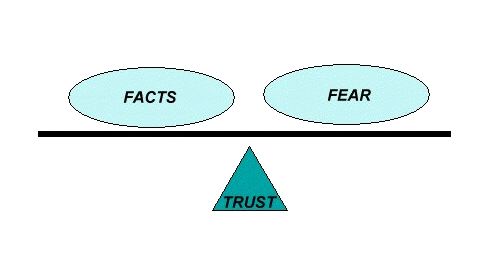retrieved from wikipedia (link):
The term military-industrial complex usually refers to the combination of the U.S. armed forces, arms industry and associated political and commercial interests, which grew rapidly in scale and influence in the wake of World War II, although it can also be used to describe any such relationship of industry and military. It is sometimes used to refer to the iron triangle that is argued to exist among weapons makers/military contractors (industry), The Pentagon (military), and the United States Congress (government).
1. Origin
The term was first used publicly by President of the United States (and former General of the Army) Dwight D. Eisenhower in his Farewell Address to the Nation on January 17, 1961:
- A vital element in keeping the peace is our military establishment. Our arms must be mighty, ready for instant action, so that no potential aggressor may be tempted to risk his own destruction...
- This conjunction of an immense military establishment and a large arms industry is new in the American experience. The total influence — economic, political, even spiritual — is felt in every city, every statehouse, every office of the federal government. We recognize the imperative need for this development. Yet we must not fail to comprehend its grave implications. Our toil, resources and livelihood are all involved; so is the very structure of our society.
- In the councils of government, we must guard against the acquisition of unwarranted influence, whether sought or unsought, by the military-industrial complex. The potential for the disastrous rise of misplaced power exists and will persist.
- We must never let the weight of this combination endanger our liberties or democratic processes. We should take nothing for granted. Only an alert and knowledgeable citizenry can compel the proper meshing of the huge industrial and military machinery of defense with our peaceful methods and goals so that security and liberty may prosper together.
In the penultimate draft of the address, Eisenhower initially used the term military-industrial-congressional complex, indicating the essential role that U.S. Congress plays in propagating the military industry. But, it is said, that the president chose to strike the word congressional in order to avoid offending members of the legislative branch of the federal government. The author of the term was Eisenhower's speech-writer Malcolm Moos.
Vietnam War-era activists referred frequently to the concept. In the late 1990s James Kurth asserted that "[b]y the mid-1980s . . . the term had largely fallen out of public discussion," and opined that "[w]hatever the power of arguments about the influence of the military-industrial complex on weapons procurement during the Cold War, they are much less relevant to the current era."
Contemporary students and critics of American militarism continue to refer to and employ the term, however. For example, historian Chalmers Johnson uses words from the second, third, and fourth paragraphs quoted above from Eisenhower's address as an epigraph to Chapter Two ("The Roots of American Militarism") of a recent volume on this subject (The Sorrows of Empire: Militarism, Secrecy, and the End of the Republic [New York: Metropolitan Books, 2004], p. 39).
The expressions permanent war economy and war corporatism are related concepts that have also been used in association with this term.
Although the term was originally coined to describe U.S. circumstances, it has been applied, by extension, to the corresponding situations in other countries. It was not unusual to see it used to describe the arms production industries and political structures of the Soviet Union, and it has also been used for other countries with an arms-producing economy, such as Wilhelminian Germany, Britain, France and post-Soviet Russia. The expression is also sometimes applied to the European Union.
- War is a Racket (book by Smedley Butler)
- Why We Fight (documentary by Eugene Jarecki)
- Corporatism
- Militarism
- Security-industrial complex
3. Sources
- Eisenhower, Dwight D. Public Papers of the Presidents, 1035-40. 1960.
- ________. "Farewell Address." In The Annals of America. Vol. 18. 1961-1968: The Burdens of World Power, 1-5. Chicago: Encyclopaedia Britannica, 1968.
- ________. President Eisenhower's Farewell Address, Wikisource.
- Hartung, William D. "Eisenhower's Warning: The Military-Industrial Complex Forty Years Later." World Policy Journal 18, no. 1 (Spring 2001).
- Kurth, James. "Military-Industrial Complex." In The Oxford Companion to American Military History, ed. John Whiteclay Chambers II, 440-42. Oxford & New York: Oxford University Press, 1999.
- Nelson, Lars-Erik. "Military-Industrial Man." In New York Review of Books 47, no. 20 (Dec. 21, 2000): 6.
4. References
Cult television show The X-Files displayed a nameless conspiracy of the American government, dominated by the Military-industrial complex's sinister machinations. This conspiracy including everything from tobacco lobbyists to extraterrestrials. Not surprisingly, some conspiracy theorists felt the show was created to disenfranchise their distrust and hide the real conspiracy. In the third season episode of the series "Jose Chung's 'From Outer Space'" series lead David Duchovny satirizes this by accusing a writer's search for the truth regarding a bizarre alien abuduction as an effort made for "the military-industrial-entertainment complex."
5. External links
- Schema-root.org: military industry 38 military industry topics, each with a current news feed
- Open Secrets: Top Defense Contributors to Federal Candidates and Parties database
- War Resisters: Piechart and info on defense spending
- Military-industrial complex on SourceWatch
- National priorities project chart showing how your federal income tax is spent
- Quotes on Money and Banking and Militarism
- Flows of Money and Patronage from Washington Truth in Recruiting
- Why We Fight : A Film by Eugene Jarecki exploring the effects of the Military Industrial Complex
SPECIAL LINKS TO RELATED POSTS INSIDE THIS BLOG:
OTHER LINKS:
- 1-Standing Armies And Armed Citizens: An Historical Analysis of The Second Amendment
- 2- Obedience to orders
- 3- Democracy and Defense: Civilian Control of the Military in the United States
- 4- Nuclear Madness and Missile Envy: The New Nuclear Danger - link 1; link 2

History
Sundance was started in 1978 as the Utah/US Film Festival in an effort to attract more filmmakers to Utah. At the time, the main focus of the event was to present a series of retrospective films and filmmaker panel discussions; however it also included a small program of films made outside the Hollywood system, commonly known as independent films.
Over the next several years factors helped propel the growth of Utah/US Film Festival. First was the involvement of actor Robert Redford. Redford, a Utah resident, became the festival's inaugural chairman and having his name associated with Sundance gave the festival great attention.
Second, the festival moved from September to January. The move from late summer to mid-winter was reportedly done on the advice of Hollywood director Sydney Pollack, who suggested that running a film festival in a ski resort during winter would draw more attention from Hollywood.
Management of the festival was taken over by the Sundance Institute, a non-profit organization, in 1985, and in 1991 the festival was officially renamed the Sundance Film Festival. Many famous independent filmmakers, including Kevin Smith, Robert Rodriguez, Quentin Tarantino, James Wan and Jim Jarmusch had their big break at Sundance. It is also responsible for bringing wider attention to films such as Saw, The Blair Witch Project, El Mariachi, Clerks., Sex, Lies, and Videotape, and Napoleon Dynamite.
Within the last ten years, corporate America has also taken notice of the festival by setting up independent marketing operations during the fesitval. This has not pleased the Sundance Film Festival, who have tried various ways to encourage brands to officially sponsor the festival, instead of creating their own marketing event. The festival has also controversially become a press event for celebrities, with stars like Ashton Kutcher, Demi Moore, and Britney Spears attending the festival.
In contrast to the "brand dance," the first non-profit space created independently and dedicated to promoting the gay and lesbian films and gay and lesbian filmmakers at the festival made an appearance at the festival in 2003. The Queer Lounge was a huge success that was created on a shoestring budget with a few corporate sponsors. The Queer Lounge has become an interesting addition to the festival festivities, as it is open to everyone, gay, straight, bisexual or otherwise who stop by during the day to learn about films in the festival with gay-themed content, attend panel discussions or just warm up at nice hospitality suite. The space is also used for the press to interview celebrities with films in the festival.
The Festival is named after The Sundance Kid, Redford's character in Butch Cassidy and the Sundance Kid.
See also
- 2006 Sundance Film Festival
- List of Sundance Film Festival award winners
- List of Sundance Film Festival selections
External links
- The Sundance Institute
- Sundance – A Festival Virgin's Guide - resources and information for festival attendees.
- UKHotMovies.com Sundance Film Festival: A Lowdown - history and background to the festival referred to as 'Cannes in the snow'
- The Queer Lounge - provides information on the films with gay and lesbian content at the Sundance Film Festival as well as a hospitality area during the festival
- [2] - GreenCine report on Sundance 2005
Documentary filmmakers came to the 2004 Sundance Film Festival with a wide range of educational, grassroots, and community-based outreach plans in mind. Some had broadcast distribution deals in place, many sought the same; others were focused on landing a theatrical deal, while some doc-makers used Sundance as a platform to kick-off their outreach campaigns.
Learning Space
During a lively Filmmaker Lodge panel entitled “Politics of Fear,” addressing the role of the documentary filmmaker in our current political climate, an audience member brought up the viability of house parties as a distribution strategy. MoveOn.org promoted this type of organizing for Robert Greenwald’s film Uncovered: The Whole Truth about the War in Iraq. MoveOn.org raised over 1 million dollars for Uncovered solely through their Internet campaign, and the film reached an estimated 100,000 people in one evening of screening at homes across the country. This new “cyber-campaign” model piqued the curiosity of filmmakers Alison Maclean and Tobias Perse. They are just beginning the process of formulating outreach and distribution plans for their film Persons of Interest, which documents the treatment of Muslim-Americans after 9/11. The film was produced by the Documentary Campaign, a not-for-profit dedicated to the production and distribution of documentary films that promote social justice and human rights.
Outreach Launch Pad
Deadline: Governor George Ryan is interviewed in Illinois.
Big Mouth Productions is another group of filmmakers who came to Sundance with an outreach strategy firmly in place. Their film Deadline, directed by Katy Chevigny and Kirsten Johnson, takes on the volatile topic of America’s capital punishment system. Deadline’s outreach campaign was launched with the film’s reception at Sundance. In attendance were ex-death row inmates and former Illinois Governor George Ryan who surprised the nation by commuting the sentences of all 167 people on Illinois death row in January 2003. The event was co-sponsored by Hands Off Cain, a league of citizens and parliamentarians for the abolition of the death penalty world-wide, and the Center on Wrongful Convictions, an organization dedicated to identifying and rectifying wrongful convictions and other serious miscarriages of justice. In partnership with these organizations, Deadline’s outreach campaign will be an extensive program including distribution of the film and its study guide to students and activists, a comprehensive Web site, and a series of death penalty symposia. The filmmakers’ goal is to present Illinois as an example that will ignite interest and action in the struggle for a global moratorium.
Born into Brothels: The most stigmatized people in Calcutta’s red light district are not the prostitutes, but their children.
Ryan’s presence at the reception generated substantial buzz and press interest and proved to be an excellent tool for inspiring dialogue about the film’s vital issues. Big Mouth Productions plans to incorporate Ryan into other outreach events at film festivals, law schools, and universities. A broadcast premiere and community screenings are also part of the plan and both will be accompanied by Web-based activist-oriented initiatives.
Ross Kauffman and Zan Briski also utilized Sundance’s built-in socializing structure to create outreach opportunities. Their film, Born into Brothels, offers a rare glimpse into the lives of children born into the red-light district of Sonagachi, Calcutta. During the course of the film, the children’s lives are transformed when they are given the opportunity and resources to express themselves through photography. Throughout the festival, the children’s extraordinary photos, both sobering and hopeful, were on display and for sale at various venues around Main Street including the Skyy View Lounge, where Al Gore was one of a packed crowd attending an HBO/Cinemax documentary film party. Sales of the photographs are used to directly help the children with the goal of providing them with lives outside of prostitution. You can learn more about this project, view the photographs and help the cause at Kids With Cameras.
Big and Small
Supersize Me: Filmmaker Morgan Spurlock resigns to eat nothing but MacDonalds for a month, and suffers somewhat dramatic consequences.
Sundance films Super Size Me and Farmingville have very different distribution strategies. On one end of the spectrum is Super Size Me, a burger-in-hand look at the legal, financial and physical costs of America’s hunger for fast food. Directed by and starring Morgan Spurlock, the film was picked up for theatrical distribution by Roadside Attractions and will hit art house screens around the country in late spring 2004. Spurlock’s journey into fast food hell has the type of cinematic edge that gives it crossover appeal and the potential for Bowling for Columbine-sized impact.
Spurlock also has a thorough educational outreach strategy: “We are planning a college tour for the film as well as making videos available to school districts, teachers, educators, counselors, health advisors, nutritionists, doctors, etc. We are currently putting together a workbook and ‘action guide’ that will help educators best utilize the video, complete with exercises suitable for a wide range of students, from K-College.”
In contrast to Spurlock’s theatrical/college-tour approach, Catherine Tambini and Carlos Sandoval’s Farmingville will use public television airwaves and community-based outreach initiatives to call attention to the impact of national immigration policies. A portrait of a small suburban town with a growing population of illegal aliens who are struggling to get by, the film was co-produced by the Independent Television and Video Service (ITVS)and will kick off the next season of the award-winning P.O.V. documentary series on June 22, 2004. P.O.V.’s wealth of outreach initiatives include Talking Back: Video and Digital Letters to P.O.V. ITVS will also be organizing outreach for the film through the Community Connections Project (CCP), in which regional organizers collaborate with national and local partners to extend the impact of documentary films.
During festival week, the Sundance Institute held a special community screening of Farmingville in Salt Lake City. The screening was presented in conjunction with Active Voice, a team of communication specialists who put socially relevant film to work for personal and global change. As with Persons of Interest, Deadline, Born into Brothels, and Super Size Me, Farmingville’s Sundance activities show that the Festival is not only a great feather in your cap, but also a terrific place for outreach, dialogue, and action.
Two films examining immigrant life in America - the Hispanicteen drama Quinceañera and the Sudanese refugee documentary God Grew Tired of Us - have won top honours at the Sundance Film Festival.
Quinceanera, written and directed by Wash Westmoreland and Richard Glatzer and featuring a cast loaded with newcomers and unknowns, won both the festival's jury prize and the audience award for US dramatic films, the latter chosen in voting by Sundance movie-goers.
Starring Emily Rios in a striking film debut as a girl ostracised by her family after she becomes pregnant shortly before her 15th birthday, Quinceanera offers a culture-clash portrait of Los Angeles' Echo Park area, traditionally a Hispanic neighbourhood that has become a trendy enclave.
Christopher Quinn's God Grew Tired of Us, which follows three Sudanese boys adjusting to life in the United States after the bloody civil war in their homeland, received both the jury prize and audience award for US documentaries.
Another immigrant story, the Mexican film De Nadie won the audience award for world-cinema documentary. Directed by Tin Dirdamal, the film traces a Central American woman's journey north in search of a new life in the United States.
A special jury prize for independent vision was awarded to director So Yong Kim's In Between Days, about a newly arrived Korean girl trying to find her place in America.
Iraq in Fragments, offering candid observations of Iraqis' lives under US occupation, won three documentary prizes: The directing and cinematography awards for James Longley and the editing honour for Longley, Billy McMillin and Fiona Otway.
The dramatic directing award went to Dito Montiel for A Guide to Recognising Your Saints, which also received a special jury prize for best ensemble performance. The film features Robert Downey Jr., Rosario Dawson, Dianne Wiest, Chazz Palminteri, Shia La Boeuf and Channing Tatum in a drama based on Montiel's youth on the mean streets of Astoria in Queens during the mid-1980s.
The Waldo Salt screenwriting award was given to writer-director Hilary Brougher for Stephanie Daley, starring Tilda Swinton and Amber Tamblyn in a drama about a teen accused of killing her newborn baby.
The French thriller 13 (Tzameti), written and directed by Gela Babluani and following a young man whose spur-of-the-moment journey turns perilous, earned the dramatic jury prize for world cinema.
The world-cinema audience prize for dramatic films went to the New Zealand's No.2, writer-director Toa Fraser's drama abouta Fijian matriarch (Ruby Dee) struggling to bring her alienated family together again.
Mexican director Juan Carlos Rulfo's In the Pit, chronicling the lives of workers building a new layer on top of abusy Mexico City freeway, won the documentary jury prize for worldcinema.
Prize-winning films were to screen one last time Sunday as the festival ended its 11-day run.
Members of the various Sundance juries included Terrence Howard, star of last year's dramatic audience-award winner Hustle &Flow, and filmmakers Alexander Payne, Andrew Jarecki, AlanRudolph and Miguel Arteta.
Among other Sundance winners:
- Tom Richmond received the cinematography award for dramatic films for director Chris Gorak's Right At Your Door drama about a couple (Mary McCormack and Rory Cochrane) separated when aterrorist attack unleashes deadly toxins in Los Angeles.
- Special jury prizes were presented to the documentaries American Blackout, director Ian Inaba's look at the disenfranchisement of black voters; TV Junkie, filmmakers Michael Cain and Matt Radecki's portrait of one man's obsession with the power of video; Philip Groening's Into GreatSilence, a glimpse of devotees' lives at the Grande Chartreuse monastery in the French Alps; and Dear Pyongyang, Japan-raised director Yonghi Yang's exploration of her father's allegiance to North Korea.
- Writer-director Julia Kwan's Eve & the Fire Horse, about two Chinese sisters seeking to reverse their family's run of bad luck, received a special dramatic jury prize for world cinema.
 The Corporation - Taking recent corporate accounting scandals as a point of departure, the filmmakers trace the origins of the corporation as a publicly regulated institution to its present-day social predominance, dwarfing and influencing governments worldwide. Along the way, corporations' ideals and benefits are weighed side-by-side with their abuses and harms by speakers ranging from CEOs and marketing professionals to economists, activists, and social critics, including Noam Chomsky and Michael Moore.
The Corporation - Taking recent corporate accounting scandals as a point of departure, the filmmakers trace the origins of the corporation as a publicly regulated institution to its present-day social predominance, dwarfing and influencing governments worldwide. Along the way, corporations' ideals and benefits are weighed side-by-side with their abuses and harms by speakers ranging from CEOs and marketing professionals to economists, activists, and social critics, including Noam Chomsky and Michael Moore. 
Inspired by Dwight Eisenhower's legendary farewell speech (in which he coined the phrase "military industrial complex"), filmmaker Jarecki (THE TRIALS OF HENRY KISSINGER) surveys the scorched landscape of a half-century's military adventures, asking how - and telling why - a nation of, by, and for the people has become the savings-and-loan of a system whose survival depends on a state of constant war.



Ominously, 37% of American children and adolescents are carrying too much fat and 2 out of every three adults are overweight or obese. Is it our fault for lacking self-control, or are the fast-food corporations to blame?
Filmmaker Morgan Spurlock hit the road and interviewed experts in 20 U.S. cities, including Houston, the "Fattest City" in America. From Surgeon Generals to gym teachers, cooks to kids, lawmakers to legislators, these authorities shared their research, opinions and "gut feelings" on our ever-expanding girth.

error, justice and life-and-death."
--Michael Wilmington, Chicago Tribune
 Persons of Interest: In this documentary, directors Alison Maclean and Tobias Perse interview 12 families touched by the U.S. Justice Department's panicked arrests and detention of 5,000 Arab and Muslim immigrants just after the World Trade Center attack.
Persons of Interest: In this documentary, directors Alison Maclean and Tobias Perse interview 12 families touched by the U.S. Justice Department's panicked arrests and detention of 5,000 Arab and Muslim immigrants just after the World Trade Center attack.
Experience 50 exclusive selections from the collection of Short Films from the 2006 Sundance Film Festival without ever needing a ticket! Free from the constraints of running time, subplots, and other feature-length expectations, this year's Short Film artists take all the chances they can. NEW PREMIERES DAILY.

WHY WE FIGHT, the new film by Eugene Jarecki which won the Grand Jury Prize at the 2005 Sundance Film Festival, is an unflinching look at the American war machine, weaving unforgettable personal histories with commentary by a "who's who" of military and beltway insiders. Featuring John McCain, William Kristol, Gore Vidal, Richard Perle and others, WHY WE FIGHT launches a bipartisan inquiry into the workings of the military industrial complex and the rise of the American Empire.
Inspired by Dwight Eisenhower's legendary farewell speech (in which he coined the phrase "military industrial complex"), filmmaker Jarecki (THE TRIALS OF HENRY KISSINGER) surveys the scorched landscape of a half-century's military adventures, asking how - and telling why - a nation of, by, and for the people has become the savings-and-loan of a system whose survival depends on a state of constant war.
SPECIAL LINKS TO RELATED POSTS INSIDE THIS BLOG:
OTHER LINKS:

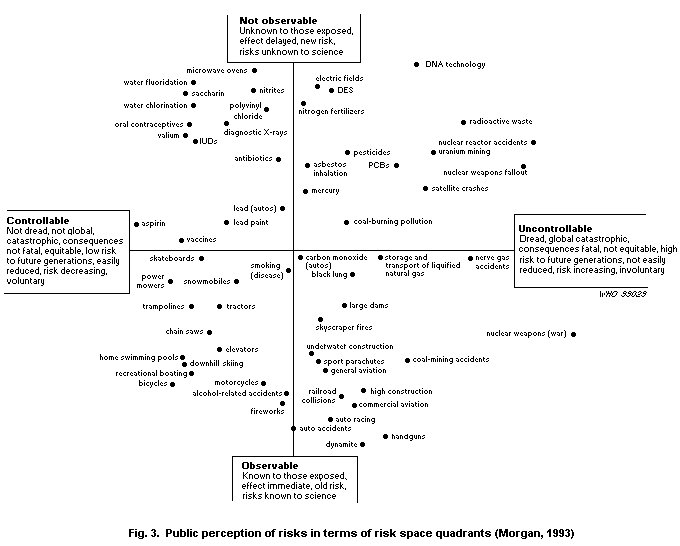
“How politicians view the public:
* Incapable of grasping complex issues
* Incapable of forming relevant views
* Believe anything they read in newspapers
* Opinions are shaped by narrow selfish concerns
* Apathetic
* Will not take the time or trouble to consider anything that does not affect them directly
In short gullible, selfish and irresponsible”
A. Coote, J. Franklin (10)
Fright /Dread Factors:
The following perceptions may make a risk seem less acceptable ie., more worrying:
* risk is involuntary
* risk seen as inequitable
* risk seen as inescapable
* source of risk unfamiliar or novel
* risk man-made rather than natural
* hidden and irreversible damage
* danger to small children or future generations
* form of harm arouses much dread
* victims identifiable not anonymous
* risk appears to be poorly understood by science
* contradictory statements from responsible sources.
Peter Bennett, David Coles, Anne McDonald, 1999 (37)
links
IMAGES (from top):
- David Ropeik, former journalist and lecturer at the Harvard School of Public Health, describes the subtle balance in risk communication between emotions (fear), facts and trust, as a see-saw in which trust is the fulcrum and facts and fear balance against each other at opposing ends.
- Public perception of risks in terms of risk space quadrants (Morgan, 1993)
-





Historical close calls
Before the collapse of the Soviet Union and end of the Cold War, an apocalyptic war between the United States and USSR was considered likely. The Cuban missile crisis in 1962 is generally thought to be the historical point at which the risk of World War III was closest. Other potential starts have included the following (see External links below for further examples):
* July 26th, 1956 – March, 1957 — Suez Crisis: the conflict pitted Egypt against an alliance between the French Fourth Republic, the United Kingdom and Israel. The USSR threatened to intervene on behalf of Egypt, the US became afraid of a larger war, and persuaded the British and French to withdraw.
* October 24, 1973 — As the Yom Kippur War was winding down, a Soviet threat to intervene on Egypt's behalf caused the United States to go to DEFCON 3.
* November 9, 1979, when the US made emergency retaliation preparations after NORAD saw on-screen indications that a full-scale Soviet attack had been launched. No attempt was made to use the "red telephone" hotline to clarify the situation with the USSR and it was not until early-warning radar systems confirmed no such launch had taken place that NORAD realised that a computer system test had caused the display errors. A Senator at NORAD at the time described an atmosphere of absolute panic. A GAO investigation led to the construction of an off-site test facility, to prevent similar mistakes subsequently. A fictionalized version of this incident was filmed as the movie WarGames, in which the test system is inadvertently triggered by a teenage hacker believing himself to be playing a video game.
* September 26, 1983, when Soviet early warning system showed that a US ICBMs attack had been launched. Colonel Stanislav Petrov, in command of the monitoring facility put the warning down to computer error and did not notify his superiors, who would have most probably launched a counter-attack.
* November 1983: Exercise Able Archer — The USSR mistook a test of NATO's nuclear-release procedures as a fake cover for a NATO attack and subsequently raised its nuclear alert level. It was not until afterwards that the US realized how close it had come to nuclear war. At the time of the exercise the Soviet Politburo was without a healthy functioning head due to the failing health of then leader Yuri Andropov, which is thought to have been one of the contributing factors to the Soviet paranoia over the exercise.
* January 25, 1995, when Russia almost launched a nuclear attack after a Norwegian missile launch for scientific research was detected from Spitzbergen and thought to be an attack on Russia, launched five minutes from Moscow. Norway had notified the world that it would be making the launch, but the Russian Defense Ministry had neglected to notify those monitoring Russia's nuclear defense systems.
In addition to the above there are two other points during the Cold War that may have resulted in world war. These, however, are not generally listed as they do not relate to the United States-Soviet Union rivalry, but rather the events following the Sino-Soviet Split of 1960. The ideological split between Maoist communists (represented primarily by China) and Stalinist communists (represented primarily by the Soviet Union) divided the entire communist movement worldwide — which controlled governments or significant rebel factions on most continents. Thus a war between China and the Soviet Union may well have resulted in world war, whilst not necessarily involving the U.S. and the capitalist west (although the U.S. may have opportunistically intervened whilst its two communist rivals were distracted by war with each other). The two points the communist powers almost entered into all-out war were:
* March, 1969, when border clashes broke out between Soviet and Chinese troops over Zhen Bao Island in the Ussuri River. In total the Soviets suffered about 90 casualties to the 800 for the Chinese. At the time there were almost one and a half million troops deployed along the border.
* 1978 and 1979, in which the pro-Soviet Vietnam invaded the pro-China Cambodia and removed Pol Pot. China in turn invaded Vietnam in retaliation and the Soviets denounced this action strongly, although it fell short of taking action. The next year the Soviets invaded Afghanistan and the Chinese claimed this was a continuation of a strategy of encircling China with Soviet allies that had begun the previous year with the invasion of Cambodia.
Some examples of close calls are more rhetorical than real. In 1999 NATO's Supreme Allied Commander, U.S. Army General Wesley Clark, ordered British Army Lt. Gen. Mike Jackson to hinder Russian troops from occupying the Pristina airport during the Kosovo War, "if necessary with military force"; Jackson refused to carry out the order with the words: "I won't start World War III for you!"
--------------------------------------------------------------------------
von Neumann said it was "absolutely certain (1) that there would be a nuclear war; and (2) that everyone would die in it" (underline added to quote from: The Nature of the Physical Universe – 1979, John Wiley & Sons, ISBN 0471031909, in H. Putnam’s essay The place of facts in a world of values - page 113). This example illustrates why respectable scientists are very reluctant to go on record with extinction predictions: they can never be proven right. (The quotation is repeated by Leslie (1996) on page 26, on the subject of nuclear war annihilation, which he still considered a significant risk – in the mid 1990s.)
--------------------------------------------------------------------------
Many people, including many of the scientists involved in the bomb project, were shocked by the devastation that the bombs produced, reports of which filtered into the United States over time. The pride which Oppenheimer had felt after the successful "Trinity" test was soon replaced by guilt and horror. "In some sort of crude sense which no vulgarity, no humor, no overstatement can quite extinguish," he later famously said, "the physicists have known sin; and this is a knowledge which they cannot lose." Los Alamos was awarded the Army-Navy "Excellence" Award shortly thereafter, and in his acceptance speech for the lab, Oppenheimer warned that:
"If atomic bombs are to be added as new weapons to the arsenals of a warring world, or to the arsenals of the nations preparing for war, then the time will come when mankind will curse the names of Los Alamos and Hiroshima. The people of this world must unite or they will perish."
--------------------------------------------------------------------------
In 1945, our collective state of mind was despair. World War II touched every inhabitable continent, leaving more than 50 million dead and millions of others as refugees. The conflict had spanned more than half a decade. It would effectively end during an interval of 43 seconds--the time it took for the atomic bomb to explode over Hiroshima after it was released by the Enola Gay on August 6. Three days later, a second bomb was dropped on Nagasaki, followed by Japan's surrender.
Sixty years later, we live in a world where the capacity for mass destruction is no longer limited to superpowers--or, for that matter, to nations. Our collective state of mind is one of vulnerability. The bombings of Hiroshima and Nagasaki are not just historical events but portents of a possible future for any city, anywhere. And it is through that lens that we find ourselves looking back at the decision of President Harry S. Truman and its legacy.
links
IMAGES (from top):
- The mushroom cloud of the atomic bombing of Nagasaki, Japan, 1945
- Hiroshima: the T-shaped Aioi Bridge, in the upper portion of the photograph, was the aim point for the Enola Gay.
- Human bones scattered across the ground in the wake of the atomic bomb of Hiroshima.
- Human remains left by a victim of the atomic attack on Nagasaki.
- Fused Lump from Hiroshima Containing Human Bones exposed to super-high temperature fires


Denial is a psychological defense mechanism in which a person faced with a fact that is uncomfortable or painful to accept rejects it instead, insisting that it is not true despite what may be overwhelming evidence. The subject may deny the reality of the unpleasant fact altogether (simple denial), admit the fact but deny its seriousness (minimisation) or admit both the fact and seriousness but deny responsibility (transference). The concept of denial is particularly important to the study of addiction.
The theory of denial was first researched seriously by Anna Freud. She classified denial as a mechanism of the immature mind, because it conflicts with the ability to learn from and cope with reality. Where denial occurs in mature minds, it is most often associated with death and dying. More recent research has significantly expanded the scope and utility of the concept. Elisabeth Kübler-Ross used denial as the first of five stages in the psychology of a dying patient, and the idea has been extended to include the reactions of survivors to news of a death. Thus, when parents are informed of the death of a child, their first reaction is often of the form, "No! You must have the wrong house, you can't mean our child!"
Unlike some other defense mechanisms postulated by psychoanalytic theory (for instance, repression), the general existence of denial is fairly easy to verify, even for non-specialists. On the other hand, denial is one of the most controversial defense mechanisms, since it can be easily used to create unfalsifiable theories: anything the subject says or does that appears to disprove the interpreter's theory is explained, not as evidence that the interpreter's theory is wrong, but as the subject's being "in denial".
------------------------------------------------------------------
The weapons used in 1945 were tiny compared to most of the approximately 30,000 nuclear weapons that exist today. A single modern weapon, exploded either intentionally or accidentally over a large city, is capable of slaughtering millions. If a larger number of weapons are exploded in warfare, the overall consequences will include not only short- and medium-term medical injuries but also severe environmental effects, disruption of transportation and delivery of food, fuel, and basic medical supplies, and possible famine and mass starvation on a global level.
The effects of a nuclear explosion are so devastating that many people today are in denial about the continued threat. And a succession of arms control agreements and the end of the Cold War have combined to create a popular myth that the threat of nuclear war has ended.
LINKS
IMAGES (from top):
- Structure of The Mind
The Structure of Personality:
The id is a reservoir of unconscious energy that includes the basic desires, and impulses with which all people are born.
The id seeks immediate gratification and operates on the pleasure principle, which guides people toward whatever feels good.
As significant others place more restrictions on direct expression of id impulses, the ego evolves from the id.
The ego operates according to the reality principle, making compromises between the unreasonable demands of the id , the practical constraints of the real world & the unreasonable demands of the superego
The superego develops as children internalize, parental and societal values into the personality.
The conscience is the part of the superego that contains the rules and the "that's a NO NO" the things people believe are wrong.
The ego ideal is the part of the superego containing an image of what you ideally can be and how you ideally ought to behave.
The superego operates on the morality principle, and violating its rules results in guilt.
- Defense Mechanisms



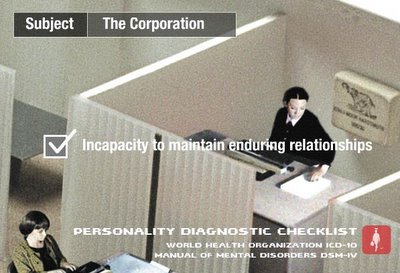
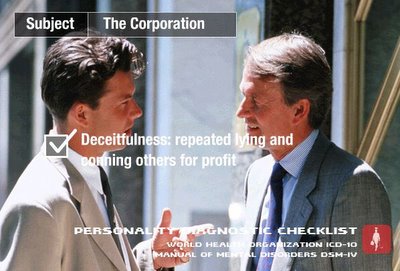

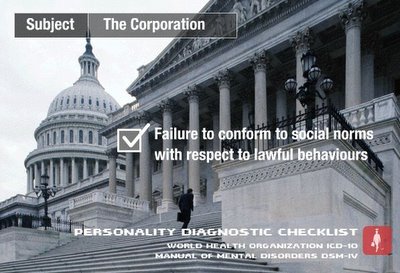
Joel Bakan tells why he sees big business as "psycho"
By Trisha Cook
A Canadian version of Michael Moore is taking a stab at the problems behind corporations with his new book and documentary.
He recently told a Toronto crowd his diagnosis: they are all literally psychotic.
Joel Bakan is following in Michael Moore’s footsteps while exposing the evils behind the capitalist mindsets of corporations in America.
Michael Moore’s renowned work Bowling for Columbine and books like Dude, Where’s My Country?, have aroused many to take a critical look at the society they are living in, recognize destructive forces and take a stand.
Corporations are psycho
Bakan wants his film The Corporation, and his new book The Corporation: The Pathological Pursuit of Profit and Power, to make people try and change the ways powerful corporations function.
"(The growing interest in such documentaries) has something to do with the idea that people feel that the world is veering off on a dangerous path," said Bakan to a packed hall at the University of Toronto. "Combined with a sense that they are not getting the information they need from the media to understand why."
Bakan, a University of British Columbia law professor and an internationally recognized scholar, spoke to over 200 people on Tuesday night.
Bakan said the turnout was unexpected and greatly appreciated. The unexpected snowstorm did not deter people from attending the free question period with Bakan. He recalled the last time he was in Toronto promoting his film, in January.
"I actually had problems in Toronto with snow before," Bakan joked. "I came to open the film, on January 16 at the Bloor Cinema. There was a lot of snow on that day as well (like the night he was speaking at U of T)- and the roof caved in."
Tough topics to tackle
Bakan tackled the destruction of the environment, globalization and human exploitation. His wit, sincerity and intellect kept the crowd rapt for about two hours.
Bakan described how he concluded that corporations are literally, not metaphorically, psychopaths.
"The other thing in law school I learned about corporations was that corporations are persons. The law actually deems them to be persons and gives them the rights that people have," said Bakan. "If the corporation is a person, well what kind of person is it? Well it’s programmed to be radically, profoundly, psychologically self-interested. And that makes it psychopathic as a person."
Bakan said,the self-serving interests that create corporations and the "Best Interest" law that serves shareholders and allows corporations to kill the environment, exploit children and create sweatshops - legally. Whatever is in the best interest of the corporation, profit-wise, is legal.
article continues
links

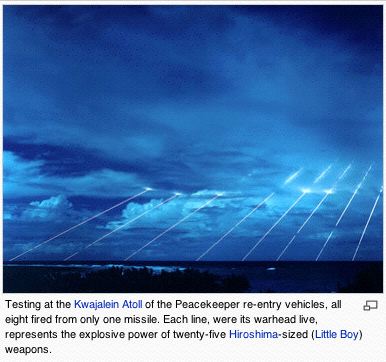
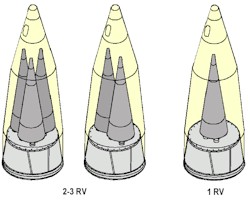



A multiple independently targetable re-entry vehicle, or MIRV, is one of a collection of nuclear weapons carried on a single intercontinental ballistic missile (ICBM) or a submarine launched ballistic missile (SLBM). Using MIRVs, a single launched missile can strike several targets, or fewer targets redundantly.
The military purpose of a MIRV is twofold :
- To reduce or eliminate the effectiveness of an anti-ballistic missile system that relies on intercepting individual warheads. While a MIRVed attacking missile can have multiple (3-12 on various US missiles) warheads, interceptors can only have one warhead per missile. Thus, in both a military and practical sense, MIRVs render ABM systems less effective, as the costs of maintaining a workable defense against MIRVs would grow astronomically, and would require multiple defensive missiles for each offensive one.
- To reduce the number of missiles required to carry out an attack. With single warhead missiles, one missile must be launched for each target. The post-boost (or bus) stage of a MIRV can dispense the warheads against multiple targets across a broad area.
--------------------------------------------------------------------------------
An Mk 941-U SSBN (Strategic Submarine Ballistic Nuclear) was launched at the Sevmash ship-yard June 26. This hard-hitting Akula (Shark)-class submarine is the biggest in the world; moreover, no other submarine displaces as much water as she does. It was named Dmitry Donskoi.
The Akula SSBN carries 20 MIRVed ICBMs (Inter-Continental Ballistic Missiles); each missile has 10 nuclear warheads and a 10,000-km range. (MIRV stands for Multiple Independent Re-Entry Vehicles -- Ed.) The Akula can hit 200 large ground targets over an area of 7,000 sq. km. with one salvo. It should be mentioned in this connection that Moscow's area totals 1,000 sq. km.
--------------------------------------------------------------------------------
Following the break-up of the Soviet Union, the pace of Russian SSBN force modernization has slowed considerably. Whereas two classes of ballistic missile submarines (SSBNs) were introduced in the 1980s (Delfin and Akula), only a single new SSBN was laid down during the 1990s (the Borey-class Yuriy Dolgorukiy), and it is still years from being completed. In contrast to earlier Soviet practices in which all three legs of the triad underwent parallel modernization programs (one exception being a relatively slow SLBM modernization program of the early 1970s), in the 1990s the modernization of the sea-going leg of the Russian nuclear triad has taken second place to the modernization of land-based ICBMs.[1]
Although some US analysts have speculated that the Yuriy Dolgorukiy would carry the R-39U [NATO designation SS-NX-28] SLBM, a derivative of the 10-warhead solid-fuel R-39 missile carried by Akulas, this missile's development began in 1985 and the decision to accept it into service was made in 1989, long before the new SSBN class was conceived. According to some Russian experts, the R-39U was intended to equip the Akulas after the service lives of their older missiles have expired.[21] The missile originally intended for the Yuriy Dolgorukiy was the Bark, or Project 3M91. A derivative of the R-39, it was nevertheless a different missile than the R-39U. A solid-fuel missile weighing 87.6 metric tons (slightly less than the 90 metric ton R-39), Bark had a throw-weight of 3.05 metric tons (as opposed to 2.55 metric tons for the R-39) and could carry up to 10 warheads. According to Director General of the Makeyev Design Bureau Vladimir Degtyar, the Bark incorporated a number of ABM system penetration-enhancing features, and could be launched on a flattened trajectory, which reduced its flight time by nearly half.[3] It was under development until 1997, when it was cancelled following three unsuccessful tests.[22]
links
IMAGES (from top):
- Minuteman III (ICBM) RV MIRV configuration
- Test at the Kwajalein Atoll
- Minuteman III (ICBM) RV configurations
- MIRV (see detailed information in picture)
- 14 kiloton atomic explosion
- LGM-30 Minuteman III MIRVs






An intercontinental ballistic missile, or ICBM, is a very-long-range (greater than 5500 km) ballistic missile typically designed for nuclear weapons delivery, i.e., delivering one or more nuclear warheads. It uses a ballistic trajectory involving a significant ascent and descent, including sub-orbital flight.
Modern ICBMs typically carry multiple independently targetable reentry vehicles (MIRVs), each of which carries a separate nuclear warhead, allowing a single missile to hit multiple targets. MIRV was an outgrowth of the rapidly shrinking size and weight of modern warheads and the Strategic Arms Limitation Treaties which imposed limitations on the number of launch vehicles(SALT I and SALT II).
ICBMs can be deployed from multiple platforms:
in missile silos, which offer some protection from military attack (including, the designers hope, some protection from a nuclear first strike)
on submarines: submarine-launched ballistic missiles (SLBMs); most or all SLBMs have the long range of ICBMs (as opposed to IRBMs)
on heavy trucks; this applies to one version of the RT-2UTTH Topol M which may be deployed from a self-propelled mobile launcher, capable of moving through roadless terrain, and launching a missile from any point along its route
mobile launchers on rails; this applies, for example, to РТ-23УТТХ "Молодец" (RT-23UTTH "Molodets" -- SS-24 "Sсаlреl")
The last three kinds are mobile and therefore hard to find.
Land-based ICBMs and cruise missiles
The US Air Force currently operates just over 500 ICBMs at around 15 missile complexes located primarily in the northern Rocky Mountain states and the Dakotas. These are of the LGM-30 Minuteman III and Peacekeeper ICBM variants. Peacekeeper missiles were phased out in 2005[2]. All USAF Minuteman II missiles have been destroyed in accordance to START, and their launch silos have been sealed or sold to the public. To comply with the START II most US multiple independently targetable reentry vehicles, or MIRVs, have been eliminated and replaced with single warhead missiles. However, since the abandonment of the START II treaty, the U.S. is said to be considering retaining 800 warheads on 500 missiles.[3]
Sea-based ICBMs
The US Navy currently has 14 Ohio-class SSBNs deployed. Each submarine is equipped with a complement of 24 Trident missiles, eight with Trident I missiles, and ten with Trident II missiles (336 missles total).
The French Navy constantly maintains at least four active units, relying on two classes of nuclear-powered ballistic submarines (SSBN): the older Redoutable class, which are being progressively decommissioned, and the newer Triomphant class. These carry 16 M45 missiles with TN75 warheads, and are scheduled to be upgraded to M51 nuclear missile around 2010.
The UK's Royal Navy has four Vanguard class submarines, each armed with 16 Trident II SLBMs.
China's People's Liberation Army Navy has one Xia class submarine with 12 single-warhead JL-1 SLBMs. The PLAN is also developing the new Type 094 SSBN that will have up to 16 JL-2 SLBMs (possibly MIRV), which are also in development.(link)
-----------------------------------------------------------------------
Submarine-launched ballistic missiles or SLBMs are ballistic missiles delivering nuclear weapons that are launched from submarines. Modern variants usually deliver multiple independently targetable reentry vehicles (MIRVs) each of which carries a warhead and allows a single launched missile to strike a handful of targets. The first successful tests of a submarine-based launch platform were by German U-boats in World War II using a submarine towed launch platform. These and other early SLBM systems required vessels to be surfaced when they fired missiles, but after World War 2, launch systems were quickly adapted to allow underwater launching. In September of 1955, the Soviet Union was the first country in the world to launch a ballistic missile from a submarine.
Ballistic missile submarines have been of great strategic importance for the USA and Russia since the Cold War, as they can hide from reconnaissance satellites and fire their nuclear weapons without much warning, even close to the opponent's coast.
(link)
------------------------------------------------------------------------
The Anti-Ballistic Missile Treaty (or ABM treaty) was a treaty between the United States of America and the Union of Soviet Socialist Republics on the limitation of the anti-ballistic missile (ABM) systems used in defending areas against missile-delivered nuclear weapons. On May 26, 1972, the President of the United States, Richard Nixon and the General Secretary of the Communist Party of the Soviet Union, Leonid Brezhnev signed the Anti-Ballistic Missile Treaty. The treaty was in force for thirty years, from 1972 until 2002. On June 13, 2002, six months after giving the required notice of intent, the US withdrew from the treaty. .(link)
------------------------------------------------------------------------
links
IMAGES (from top):
- SLBN Comparison
- Polaris A3
- LGM-118A Peacekeeper ICBM
- LGM-118A Peacekeeper ICBM's W87 MIRV (Multiple independently targetable reentry vehicle)
- diagram: LGM-118A Peacekeeper ICBM
- LGM-118A Peacekeeper ICBM with W87 MIRVs indicated in red














